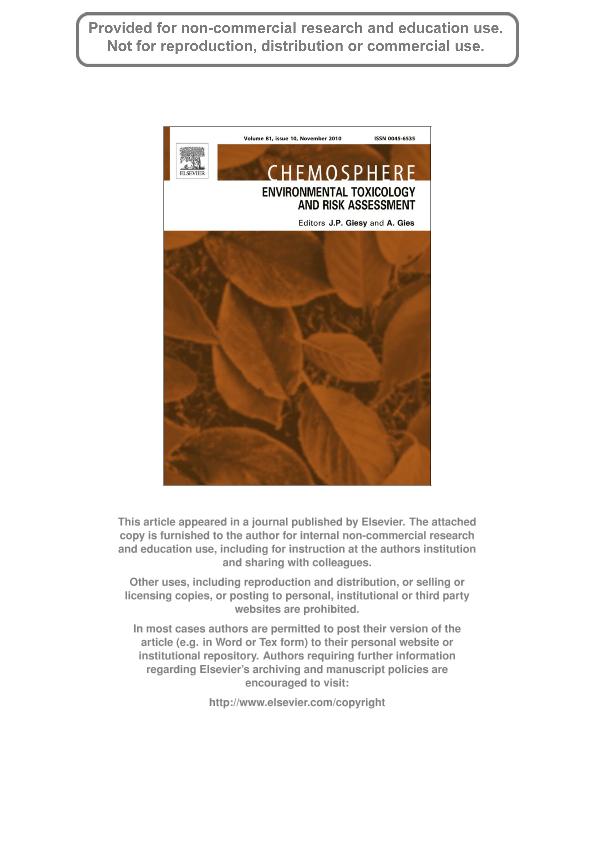Mostrar el registro sencillo del ítem
dc.contributor.author
Junges, Celina Maria

dc.contributor.author
Lajmanovich, Rafael Carlos

dc.contributor.author
Peltzer, Paola

dc.contributor.author
Attademo, Andres Maximiliano

dc.contributor.author
Basso, Agustin

dc.date.available
2020-02-14T20:40:50Z
dc.date.issued
2010-11
dc.identifier.citation
Junges, Celina Maria; Lajmanovich, Rafael Carlos; Peltzer, Paola; Attademo, Andres Maximiliano; Basso, Agustin; Predator-prey interactions between Synbranchus marmoratus (Teleostei: Synbranchidae) and Hypsiboas pulchellus tadpoles (Amphibia: Hylidae): Importance of lateral line in nocturnal predation and effects of fenitrothion exposure; Pergamon-Elsevier Science Ltd; Chemosphere; 81; 10; 11-2010; 1233-1238
dc.identifier.issn
0045-6535
dc.identifier.uri
http://hdl.handle.net/11336/97671
dc.description.abstract
Environmental contaminants can disrupt interactions between aquatic species by altering community structure. We explored predator-prey interactions between marbled swamp juvenile eels (Synbranchus marmoratus; predator) and anuran tadpoles (Hypsiboas pulchellus; prey) in relation to two aspects: the importance of lateral line in the predator and whether the absence of light modifies predation rates; and the effect of a sub-lethal concentration of fenitrothion on both predator and prey. Eels were tested under two sensory conditions (lateral line intact and lateral line blocked by cobalt chloride) in dark conditions. Predation rates were evaluated using different treatments that combined predator and prey exposed or not to insecticide. Acetylcholinesterase (AChE) and butyrylcholinesterase (BChE) activities were also measured in muscle samples of eels and tadpoles to explore whether fenitrothion affects predator and prey differentially. Marbled swamp eels were more efficient in feeding on tadpoles during the night than during the day, showing that lateral line makes an important contribution to prey detection and capture. Regarding pesticide effects, short-term (6h) exposure to an ecologically relevant fenitrothion dose of 2.5mgL-1 altered the predator-prey relationship by changing prey behaviour, reducing prey detection and therefore increasing tadpole survival. At this concentration, the outcome of the predator-prey relationship appears biased in favor of the exposed tadpoles, which were released from predation risk, despite their altered behaviour and the higher inhibition percentages of tail BChE (70%) and AChE (51%) than in control individuals. Our study involving these model species and agrochemicals demonstrates that fenitrothion affected the outcome of a predator-prey relationship. Further studies are needed, in these species and other native amphibians, to investigate the nature of the mechanisms responsible for the adverse effects of pesticides on antipredator behaviour and predation efficiency.
dc.format
application/pdf
dc.language.iso
eng
dc.publisher
Pergamon-Elsevier Science Ltd

dc.rights
info:eu-repo/semantics/openAccess
dc.rights.uri
https://creativecommons.org/licenses/by-nc-sa/2.5/ar/
dc.subject
ACETYLCHOLINESTERASE
dc.subject
BUTYRYLCHOLINESTERASE
dc.subject
LATERAL LINE
dc.subject
MARBLED SWAMP EEL
dc.subject
PREDATION RATE
dc.subject
TADPOLES
dc.subject.classification
Zoología, Ornitología, Entomología, Etología

dc.subject.classification
Ciencias Biológicas

dc.subject.classification
CIENCIAS NATURALES Y EXACTAS

dc.title
Predator-prey interactions between Synbranchus marmoratus (Teleostei: Synbranchidae) and Hypsiboas pulchellus tadpoles (Amphibia: Hylidae): Importance of lateral line in nocturnal predation and effects of fenitrothion exposure
dc.type
info:eu-repo/semantics/article
dc.type
info:ar-repo/semantics/artículo
dc.type
info:eu-repo/semantics/publishedVersion
dc.date.updated
2020-02-13T18:59:22Z
dc.journal.volume
81
dc.journal.number
10
dc.journal.pagination
1233-1238
dc.journal.pais
Reino Unido

dc.description.fil
Fil: Junges, Celina Maria. Consejo Nacional de Investigaciones Científicas y Técnicas; Argentina. Universidad Nacional del Litoral. Facultad de Bioquímica y Ciencias Biológicas; Argentina
dc.description.fil
Fil: Lajmanovich, Rafael Carlos. Consejo Nacional de Investigaciones Científicas y Técnicas; Argentina. Universidad Nacional del Litoral. Facultad de Bioquímica y Ciencias Biológicas; Argentina
dc.description.fil
Fil: Peltzer, Paola. Consejo Nacional de Investigaciones Científicas y Técnicas; Argentina. Universidad Nacional del Litoral. Facultad de Bioquímica y Ciencias Biológicas; Argentina
dc.description.fil
Fil: Attademo, Andres Maximiliano. Consejo Nacional de Investigaciones Científicas y Técnicas; Argentina. Universidad Nacional del Litoral. Facultad de Bioquímica y Ciencias Biológicas; Argentina
dc.description.fil
Fil: Basso, Agustin. Universidad Nacional del Litoral. Facultad de Bioquímica y Ciencias Biológicas; Argentina
dc.journal.title
Chemosphere

dc.relation.alternativeid
info:eu-repo/semantics/altIdentifier/doi/http://dx.doi.org/10.1016/j.chemosphere.2010.09.035
dc.relation.alternativeid
info:eu-repo/semantics/altIdentifier/url/https://www.sciencedirect.com/science/article/abs/pii/S0045653510010507
Archivos asociados
